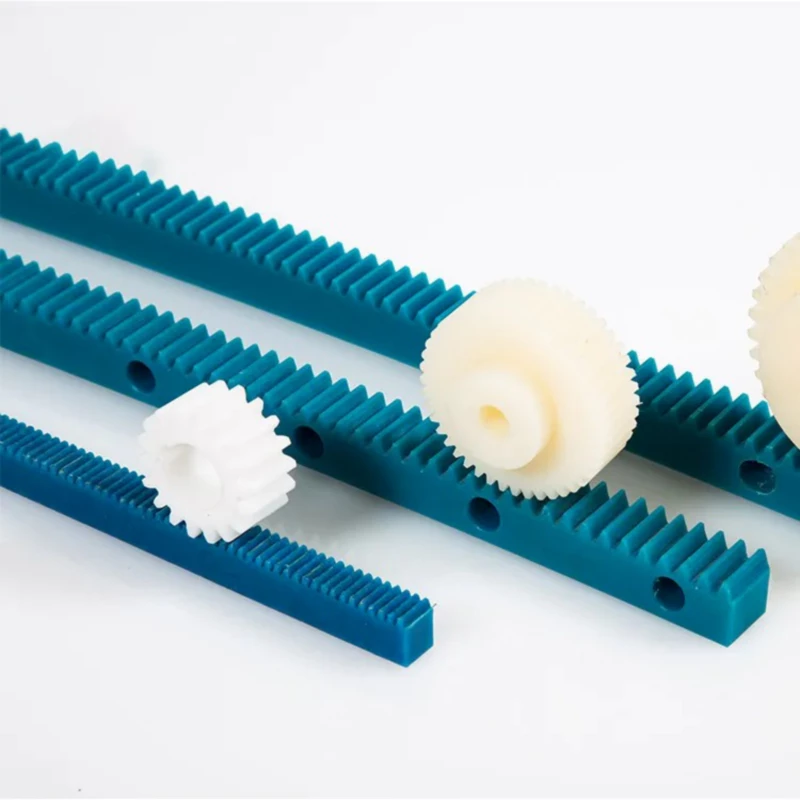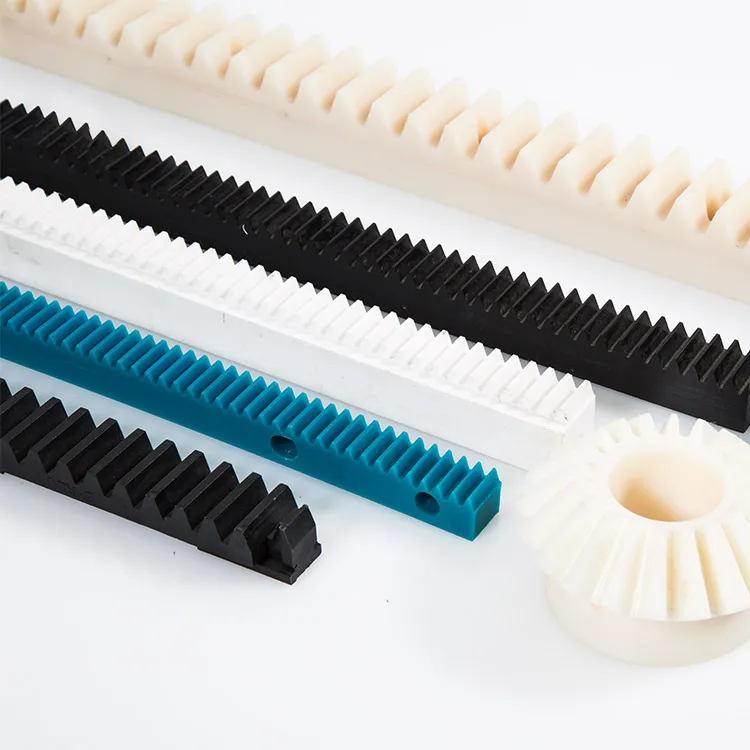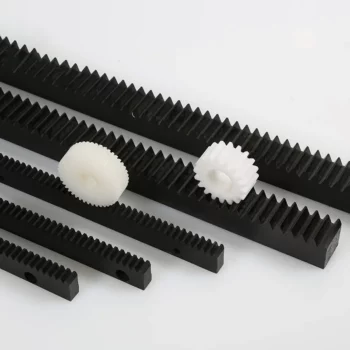What are the Speed Limitations of Plastic Gear Racks?
Plastic Gear Racks are mechanical components made from various types of plastic materials and are used to transmit power and motion in various applications. They consist of a linear series of teeth that mesh with a gear, converting rotational motion into linear motion or vice versa.
Structure and Materials
A. Composition of Plastic Rack
Plastic Gear Racks are primarily composed of a sequence of teeth and gaps. The design of the rack and the profile of the teeth are crucial in ensuring efficient force transmission and motion. The precise arrangement and shape of the teeth determine the smoothness and efficiency of the gear rack system.
The teeth must be designed to withstand the required load without deformation. The spacing and alignment need to be precise to prevent slippage and ensure smooth operation. Additionally, the material used should provide the necessary strength and durability while minimizing wear and tear.
B. Commonly Used Plastic Materials
Several types of plastic materials are commonly used to manufacture gear racks, each offering unique properties:
- Polyamide (PA)
- Polyethylene (PE)
- Polypropylene (PP)
Polyamide is known for its excellent strength and wear resistance. Polyethylene offers a good balance of toughness and flexibility, making it suitable for various applications. Polypropylene is lightweight and resistant to many chemicals, making it ideal for environments where exposure to corrosive substances is likely.

Advantages
1. Lightweight and Corrosion Resistance
Plastic Gear Racks are significantly lighter than their metal counterparts, reducing the overall weight of the machinery they are used in. Additionally, the inherent corrosion resistance of plastics ensures longevity even in harsh environments.
2. Low Noise and Low Friction
One of the critical benefits of plastic gear racks is their ability to operate quietly. The low friction between plastic components reduces noise, making them suitable for applications where noise levels are a concern.
3. Cost-Effective and Easy to Process
Plastic Gear Racks are generally more cost-effective to produce than metal ones. The ease of processing plastics allows for more straightforward manufacturing and customization, reducing production costs and time.
4. Design Flexibility
Plastic materials can be easily molded into complex shapes, providing significant design flexibility. This adaptability allows for the creation of custom gear racks tailored to specific applications and requirements.
5. Resistance to Chemicals and Moisture
Plastics are often resistant to a wide range of chemicals and moisture. This makes plastic gear racks suitable for use in environments where exposure to chemicals or moisture is common, ensuring durability and performance.
6. Reduced Wear on Other Components
The softer nature of plastic compared to metal means that plastic gear racks tend to cause less wear on mating components, extending the lifespan of the entire system. This attribute is particularly valuable in applications requiring frequent operation.

Applications
Automation and Robotics
Plastic Gear Racks are widely used in automation and robotics systems for precise motion control and power transmission. They are utilized in robotic arms, gantry systems, linear actuators, and other automated machinery, providing reliable performance in these high-precision applications.
Electric Tools and Appliances
Plastic Gear Racks are employed in electric tools such as drills, saws, and sanders, where they help convert rotational motion into linear motion. Additionally, they are used in household appliances like mixers, blenders, and printers for smooth and efficient operation.
Transportation and Automotive
Plastic Gear Racks are utilized in various transportation and automotive applications. They can be found in steering systems, seat adjustment mechanisms, window regulators, and convertible tops, providing reliable and precise movement.
Medical Equipment
Plastic Gear Racks are used in medical equipment such as hospital beds, patient lifts, and adjustable tables. Their lightweight, corrosion-resistant, and low-noise properties make them suitable for healthcare settings.
Packaging and Material Handling
Plastic Gear Racks are employed in packaging and material handling machinery to facilitate the movement of products along conveyor systems or for precise positioning in packaging operations.
Industrial Machinery
Plastic Gear Racks are utilized in various industrial machinery, including CNC machines, cutting systems, textile machinery, and printing presses. Their low friction and wear properties contribute to smooth operation and reduced maintenance.
Agricultural Equipment
Plastic Gear Racks find applications in agricultural machinery, such as crop harvesters, seeders, and irrigation systems. They help in the efficient movement of components and ensure precise control in agricultural operations.
Recreation and Sports Equipment
Plastic Gear Racks are used in recreational and sports equipment, such as exercise machines, bicycles, and golf carts, to convert rotational motion into linear motion for enhanced performance.
Renewable Energy Systems
Plastic Gear Racks are employed in renewable energy systems, including solar panel tracking systems and wind turbine pitch control mechanisms, to optimize energy generation and tracking capabilities.


Installation and Maintenance
Installation
1. Choose an Appropriate Installation Location
Selecting a suitable location for installing the plastic gear rack is crucial. Ensure the area is clean, dry, and free from potential contaminants.
2. Align and Secure
Proper alignment of the gear rack with the mating gear is essential for smooth operation. Secure the gear rack firmly in place to prevent any movement during operation.
3. Adjust Tension
Adjust the tension of the gear rack to ensure optimal performance. Too much or too little tension can lead to premature wear or operational inefficiencies.
Maintenance
1. Regular Cleaning
Regularly clean the gear rack to remove any dirt, debris, or contaminants that may affect its performance. Use appropriate cleaning agents and methods to avoid damaging the plastic material.
2. Lubrication
Apply lubrication to the gear rack periodically to reduce friction and wear. Use lubricants compatible with the plastic material to prevent deterioration.
3. Inspect and Replace Worn Parts
Regularly inspect the gear rack for signs of wear or damage. Replace any worn or damaged parts promptly to maintain optimal performance and prevent further issues.
4. Avoid Overloading and Improper Use
Avoid subjecting the gear rack to loads beyond its designed capacity. Proper use and maintenance practices help extend the lifespan of the gear rack.
5. Regularly Inspect and Maintain Related Components
Regularly inspect and maintain other components in the system to ensure they are in good condition and functioning correctly. Address any issues promptly to avoid affecting the performance of the gear rack.

How to Choose the Right Plastic Gear Rack
1. Load Capacity
Consider the load capacity required for your application. Ensure the plastic gear rack can handle the expected loads without deforming or failing.
2. Gear Module
The gear module refers to the size of the teeth on the gear rack. Select a gear module that matches the specifications of the mating gear for optimal performance.
3. Rack Length and Dimensions
Choose a gear rack with the appropriate length and dimensions for your application. Ensure it fits within the available space and meets the operational requirements.
4. Material Selection
Select a plastic material that offers the necessary properties for your application, such as strength, wear resistance, and chemical resistance.
5. Accuracy Requirements
Consider the accuracy requirements for your application. Choose a gear rack with the necessary precision to ensure smooth and reliable operation.
6. Environmental Conditions
Consider the environmental conditions in which the gear rack will operate. Select a material that can withstand the temperature, humidity, and exposure to chemicals or moisture.
7. Manufacturer Reputation and Quality
Choose a gear rack from a reputable manufacturer known for producing high-quality products. Consider